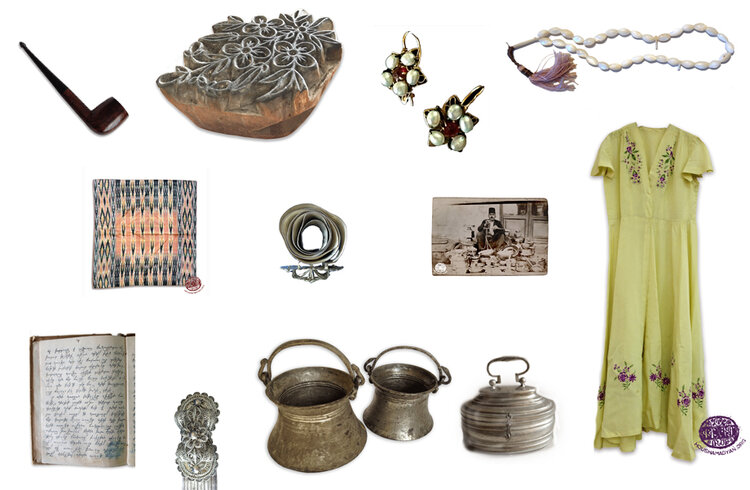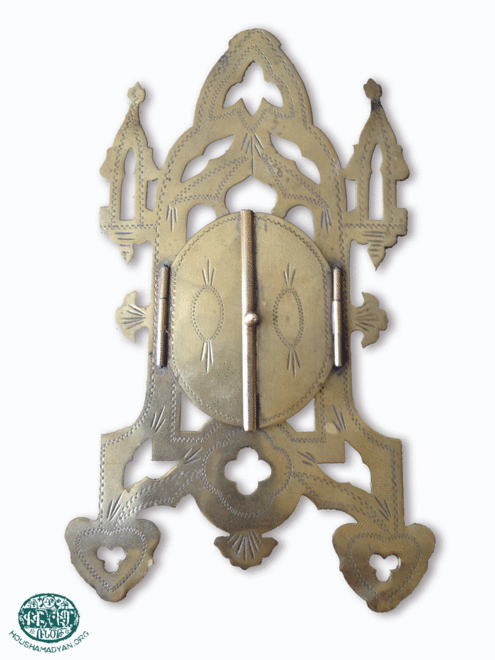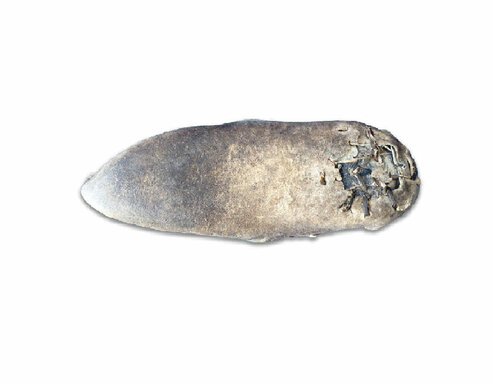Hamazkaine school Marseille - France
In May 2015, Houshamadyan conducted a workshop with the students of the Hamazkaine School in Marseille, for the purpose of including students in the process of gathering archival material on Ottoman Armenians. After the workshop, the students found some very interesting photographs and materials, which you can see in this section.
This belt and bracelet belonged to Seta Biberian’s maternal grandmother, Anaïs Shahinian (later Kalarian), who was born in Trabzon, probably in 1914. The belt and the bracelet are most probably Garbis Shahinian’s -Anaïs’s father- handiwork. He was a jeweler in Trabozn and was married to Haygouhi.
In 1915, the Shahinian family moved to Istanbul, later they went to Greece, then Bulgaria and in the 1920’s they settled in Paris. Anaïs had 4 daughters. She turned a silver belt she had from Trabzon into 4 bracelets by cutting the belt into 4 parts - one bracelet for each daughter. The bracelet you see here is one of these four; the clasp was added later to the bracelet.
The belt and the bracelet are currently in the possession of Seta Biberian in Marseille.
Belt length: 106, 05 cm, width: 3,05 cm
This frame belonged to Hripsime Paladjian (?, Stanos – 1930, Marseille). The Paladjians, who survived the genocide, went to Marseille and took this frame with them. They also had two spoons along with this frame, however these got lost during their journey. The frame was passed on to Hripsime’s daughter, Gulemiye Paladjian (later Chakerian), who was also born in Stanos (present-day Yenikent) in 1911. In 1946, Gulemiye and her family immigrated to Armenia, taking the frame with them. In 1990, the descendants of the Paladjian family returned to Marseille, the frame with the picture of Jesus went with them.
It is currently in the possession of Isabel Baghchadjian (Hripsime’s great-granddaughter) in Marseille.
Tania Ishchi, a student from the Marseille Hamazkaine School, provided this light green/sky blue wooden trunk from her family collection.
It belonged to Ohanness Çakıroğlu, who was born in the Herek/Erbaa village of Tokat in 1900, and who died in Istanbul in 1992. After the genocide, Ohanness and his brother settled in Istanbul, having brought the trunk with them. Ohanness’s daughter, Baydzar, was born in Istanbul in 1940. She inherited the trunk. In 1995, Baydzar took the trunk with her to Marseille where she settled.
The trunk is currently in the possession of Ohanness’s granddaughter, Carmen Ishchi (born Tanjan) in Marseille.
Eva Gracian, a student from the Marseille Hamazkaine School provided to us this shoe and document from her family’s collection.
These belonged to Khoren Der Nazaretian (Eva's great-grandfather) who was born in the village of Lsonk in the region of Papert/Bayburt on the 7th of October, 1891; he died in November 1976. Khoren Der Nazaretian was one of General Antranig Ozanian’s volunteers in the Caucasus. In 1917, they were in Goris. In his diary, Khoren tells of his time in Goris and that he spent 8 months in the village of Degh in a cave like home. He then moved to Thessaloniki and later to Marseille in 1923. In 2011, Khoren’s daughter in law, Isgouhi Nazaretian-Gracian (born in 1937), who is settled in Marseille, found Khoren’s diary and visited the described place in Goris and finds these sandals (drekh) in the cave exactly as Khoren had described. She brought the sandals back with her to Marseille.
The sandals and the document are currently in the possession of Khoren’s grandson, Armen Gracian, in Marseille.
The sandal is 30 cm long and 11 cm wide.
Azad Eurdekian: Embroidery and photo, Hüdaverdigar/Bursa
This text was written in Armenian by Azad Eurdekian himself:
"This piece was embroidered by my paternal great-grandmother, Aghavni Dogramadjian. She finished it in 1913 in Bursa. Her husband, who was a tailor, would give her a lot of thread to work with. During the beginning of the Genocide, Aghavni gave the embroidery to a distant cousin who did not get exiled because she was married to an Italian dentist who lived in Istanbul. The cousin kept the embroidery and later moved to France taking it with her. In France, she met Aghavni's daughter Nazeni, and gave it to her as a present. This is how this piece of embroidery survived; it is now hanging on the wall of my paternal grandparents' house. This embroidery shows Mother Armenia in the middle of the ruins of Armenia. There are weapons on the ground and we can read the names of historical Armenia's famous cities such as Sis, Dikranagerd, Van, Garin, Ani, Vagharshabad, Dvin, Nakhichevan, Armavir and Ardashad. We can see the river Araks and the mountain Ararat in the back."
Children's bracelet and ring, Dikranagerd/Diyarbakır
This piece of jewelry for babies is from Dikranagerd/Diyarbakır. It is made of silver and lead and has a rattle chain, to which are attached a ring, a bracelet and a baby teether, used for relieving teething pain.
The piece of jewelry belonged to Brigitte Markoyan’s maternal grandfather, Mihran Nakashian, who was born on the 3rd of May, 1903, in Dikranagerd/Diyarbakır. The bracelet currently belongs to and is worn by Ishkhan, Brigitte Markoyan’s sister’s great-grandson who is still a baby, and it is currently kept in Marseille.

This is an old version of today's baby "teethers". Being attached to the bracelet and ring through a rattle chain, the baby would use it while teething. The cold of the silver and lead would relieve the teething pain and it was practical because it would not get lost.
This ring is also from Dikranagerd/Diyarbakır, it belonged to Brigitte Markoyan’s grandfather’s grandmother and as such probably dates back to 1860-1870. Brigitte Markoyan’s grandfather, Mihran Nakashain, moved to Marseille with his family in 1923 bringing the children’s bracelet and the ring with him.





















